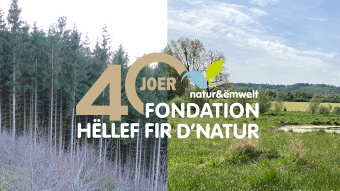40 years - 40 natural reserves – Schlammwiss
The Schlammwiss is the largest reedbed in Switzerland, covering an area of 20 ha.
The Schlammwiss reserve is listed as a "wetland" under the official designation "RN ZH 51 Uebersyren - Schlammwiss/Schlammwiss - Aalbaach". It is located in the European Special Protection Area LU2006 "Syre Valley", which covers 375 ha along the Syre and is part of the European nature conservation network Natura 2000.
Due to the unique and fragile nature of this wetland, it has been declared a Special Area of Conservation according to the European Directive 79/409/EEC, the so-called "Birds Directive", and is one of the 12 bird protection areas of the Natura 2000 network in Luxembourg. Thanks to this status, it benefits from regulations and strategies for the protection of wild birds and their habitats.
In this protection area of the Schlammwiss, 20 ha of land have been acquired by the Fondation Hëllef fir d'Natur de natur&ëmwelt in order to protect this unique site in the long term. An application for the classification of the mudflats as a national nature reserve by grand-ducal regulation is underway. Thus, this wetland will be able to benefit from strategies of protection of the fauna and flora because of its richness, its rarity and the specificity of its habitats.
The Schlammwiss nature reserve is a wetland of 88 ha extending from Uebersyren to Mensdorf on the major bed of the Syra. It also includes 20 ha of reed beds near Munsbach and the Aalbaach valley. It represents the confluence of several tributaries of the western slope, the Munsbach, the Aalbach and the Bouneschbach with the Syra. This protected area connects different communities like Niederanven, Betzdorf, Schuttrange and the villages of Uebersyren and Mensdorf.
A specific reserve
The Schlammwiss nature reserve is the largest reed complex in the Grand Duchy of Luxembourg with a length of 1 km and a width of 30 to 120 m on a surface of 20 ha. There are also several water bodies (ponds and pools) and an orchard with a nature trail. The forests adjacent to the site attract numerous species such as the black woodpecker or the green woodpecker.
A remarkable biodiversity can be observed in the whole alluvial plain. Several monitoring surveys have highlighted the extraordinary biodiversity not only of birds, but also of plants with rare species such as the swamp walnut and the vigorous cattail or amphibians, insects like dragonflies and grasshoppers.
Text: Fondation Hëllef fir d’Natur
COPYRIGHT: Nordliicht.lu








